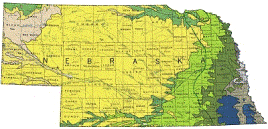United States Geological Survey

United States Geological Survey: Staff Publications
Document Type
Article
Date of this Version
2000
Abstract
Peoria Loess deposited in western Iowa during the last glacial maximum (LGM) shows distinct geochemical and particle-size variations as a function of both depth and distance east of the Missouri River. Geochemical and particle-size data indicate that Peoria Loess in western Iowa probably had two sources: the Missouri River valley, and a source that lay to the west of the Missouri River. Both sources indicate that LGM paleowinds in western Iowa had a strong westerly component, similar to interpretations of previous workers. A compilation of loess studies in Iowa and elsewhere indicates that westerlv winds were dominant during loess transport over much of the mid-continent south of the Laurentide ice sheet, which is not in agreement with paleowinds simulated by atmospheric general circulation models (AGCMs). AGCMs consistently generate a glacial anticyclone with easterly or northeasterly winds over the Laurentide ice sheet and the area to the south of it. Loess deposition in the mid-continent during the LGM may be a function of infrequent northwesterly winds that were unrelated to the presence of the glacial anticyclone


Comments
Published in Quaternary Research 53, 49-61 (2000).